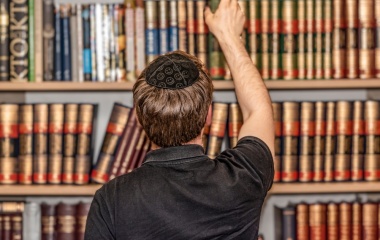
Rashi begins his commentary to Chumash asking why the Torah begins with the story of creation and not with the first mitzva given to the Jewish people, that of establishing a calendar. Put slightly differently, Rashi wonders why do we begin with a divine clock and not a human one? Rashi answers that the Torah wanted to impress upon us that the world is G-d’s to divide as He pleases. In other words, the Torah opens with the notion of kabbalat malchut shamayim, the acceptance of G-d’s kingship.
The Talmud, essentially an explication of the Torah, begins by asking "Meimati korin et hashema b'aarvin? What is the earliest time one may recite the evening shema? It is through the recital of the shema that we accept upon ourselves G-d's kingship.
The Mishna could have simply said when the sun sets, or, depending on one’s definition of night, when the first stars come out. Instead the Mishna answers “from the time the kohanim enter to eat their terumah”. Terumah, a gift of produce that each farmer must give to the kohen, may be eaten only by the kohen and his family, and only in a state of purity. Depending on the source of tumah, one might be tameh for one day, two days or seven days. While the kohen was allowed to go to the mikva during the day, his state of purity—and hence, permission to eat terumah—only began at night. Eager to eat terumah, the kohanim would do so at the earliest possible moment, signalling to all that night had begun and the time had arrived to recite the evening shema.
That this answer is unnecessarily complex hardly needs to be stated. But beyond the complexity this answer is of little help. Firstly, it seems to contravene the halacha that one is not supposed to eat before recital of the shema[1]. Kohanim too must recite the shema; by what right can they eat first? Practically speaking, how would the average Jew know when the kohanim go to eat their terumah? Is there a special kohen restaurant where all who were tameh go to eat their terumah? And even if so, presumably they did not all do so at the same time. If by chance one does see a kohen eating terumah around nightfall how would one know if he is a kohen who was tameh eating terumah at the first possible moment or a kohen who was not tameh and hence could eat terumah whenever he wanted. Does the Mishna expect one to go ask the kohen?
Even if we could explain all the above, the Mishna’s answer is historically incomprehensible. The Mishna was redacted at the beginning of the third century CE, fully 150 years after the Temple was destroyed. With the eating of terumah requiring tahara, and with no mechanism to purify oneself, these laws fell into abeyance. No Jew reading the Mishna had ever seen a kohen eating terumah.
No one understood the need to adapt Jewish life to this new reality better than Rebbe Yehudah Hanassi, the lead editor of the Mishna. Fully cognizant of the needs of the hour, and aware of the great historic need, he made the decision—one contrary to Jewish law—to put the Oral Law in writing in the form of the Mishna. With destruction, dispersion and dislocation the lot of the Jewish people, there was little choice.
While primarily a code of Jewish law, the Mishna is so much more. Born in tragedy the Mishna begins with a message of hope. There may be no tumah and no tahara, no Temple and no terumah, no priesthood and no purity, but this is no more than a temporary glitch of history. One day we will witness kohanim eating terumah, celebrate the changing of the guard at the Temple (the marker for the latest time for reciting the shema) and the laws of purity will once again be most relevant.
And one need look no further than the shema for this message of hope. “And you shall love the Lord your G-d with all your heart, with all your soul and with all your might”. ‘With all your soul’—even if He (he?) is taking your soul”. So taught Rabbi Akiva as he was being tortured to death by the Romans (Brachot 61b). This is the same Rabbi Akiva who could laugh when seeing foxes scampering around the Temple Mount (Makkot 24a). It may be dark outside but when darkness strikes it is time to say the shema; to see hope where others may despair. And perhaps this is the reason that recital of the shema is the only time bound mitzva we must do both by day and night. The night may be long but after night comes day.
Jewish history has witnessed too many lengthy periods of night, more than Rebbe or Rabbi Akiva could ever have imagined[2]. None darker than what began some 16 years after Rav Meir Shapiro proposed the idea of Daf Yomi. But thank G-d the sun has begun to rise. A people that wandered from place to place have come home. Laws that have been dormant for centuries have come back to life. Let us hope that we will soon say the shema upon seeing the kohanim enter to eat terumah.
[1] The permission for us to do so is based on the notion that we have a minyan kavuah, a set time we go to shul to daven. Once evening arrives, one who will not be going to shul for maariv should, halacah lemaaseh, in actual practice, refrain from eating until reciting the evening shema. The halacha that one must refrain from personal activities when it is time to do a mitzva applies to all mitzvot, from bedikat chametz to tekiat shofar, lighting chanukah candles or hearing the Megillah.
[2] It is not surprising that some 70 years after the destruction of the second Temple Rabbi Akiva foresaw the building of the third Temple and hence could believe that Bar Kochva was the mashiach. And some 70 years later Rabbi Yehuda Hanassi committed the Mishna to writing.



